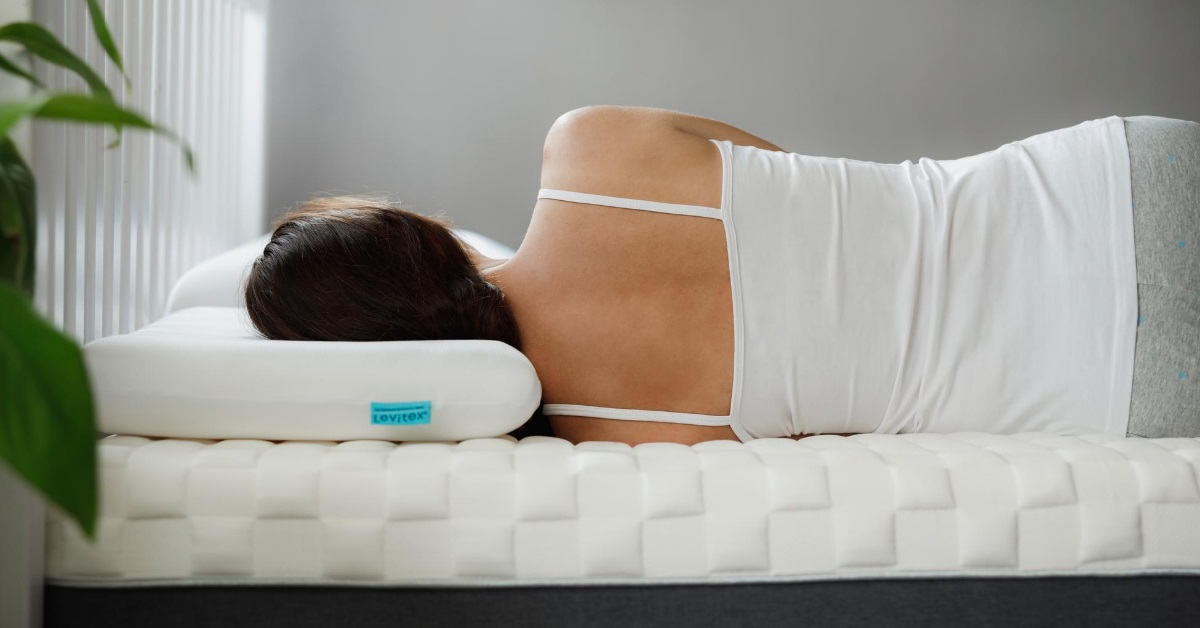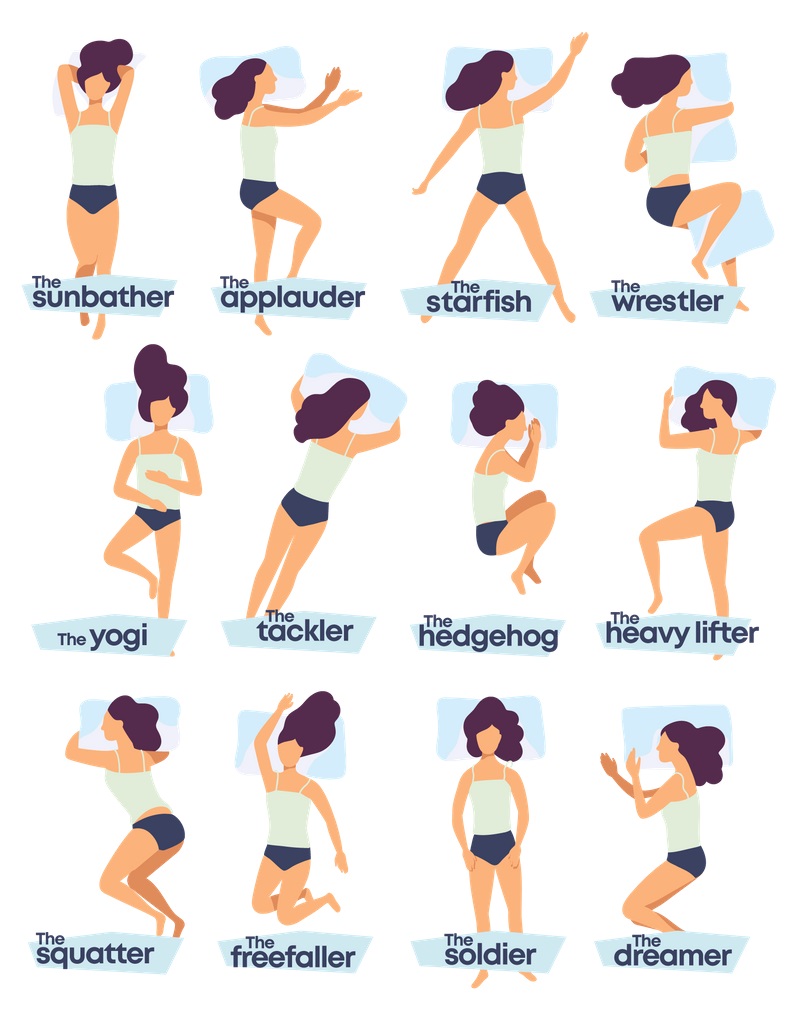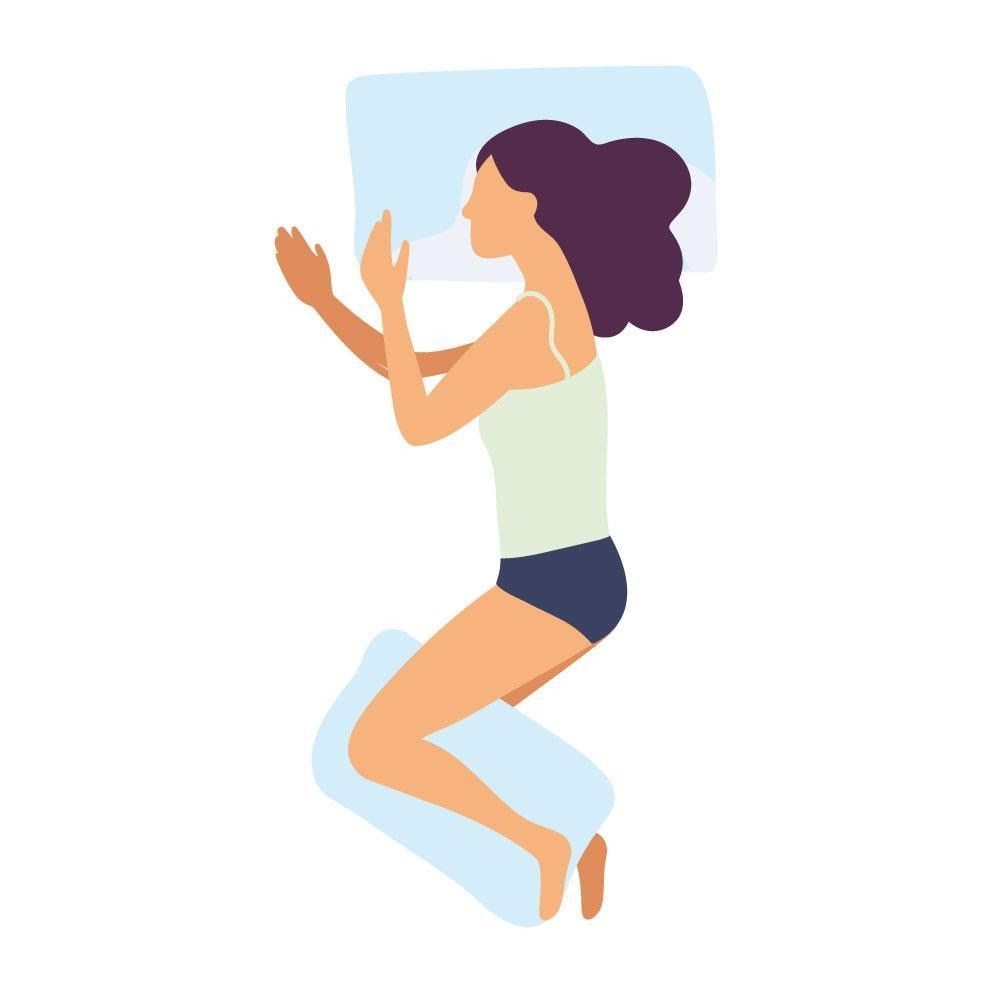Mon 17 Jan 2022 • Christina Hunt
Sleep Posture: A Cheat’s Guide To Quality Sleep | Levitex Sleep

Summer 2021 | Beyond the Asanas
Whether it is 3h or 9h a night, we all sleep. We focus on our wellbeing, maintain the perfect posture in the tree position, know not to let our spine round in downwards facing dog, so now the attention is turning to the quality of our sleep and what we lie on.
However many hours you manage, it would be ideal if the time you spend in bed could be optimised. How do we do this? Sleep Posture.
What Is Sleep Posture Really And Why Haven’t I Heard Of It Before?
When you were little, your parents likely reprimanded you for slouching, rather than sitting up straight. We may have even been sent to bed at a certain time, but none of us were ever sent to bed and told to sleep in a certain way.
Sleep Posture is the position of our body at night. The most common one? For the majority of us, it is on our side (lateral), followed by the back (supine). Not many of us sleep directly on our front (prone), and thankfully so – it is the position in which the most stress is applied to our spine. The ideal sleep posture is one that requires the least tension and achieves neutral spinal alignment.

Neutral spinal alignment in a side lying position
Since the late 80s, it has been well evidenced by Gracovetsky (of Concordia University Montreal) that the optimal sleeping position is side lying, in a semi-foetal way. It applies the least pressure to your spine. However, while we only usually refer to the three main lying positions, people adapt these in MANY different ways.
This means that it is not enough to just talk about the side or the front – because you may be on your side, but also have one knee hanging over the other leg. That knee may not seem like a big deal, but it causes your hips to rotate, which in turn puts unnecessary tension through your spine.
Here is a sample of some of the most popular sleeping positions. If you can spot yourself, and you are not the dreamer or the soldier, then you definitely need to keep on reading.
Being a yogi is great. Just not while you sleep.

Most popular sleep positions according to Levitex’s research
How Does Sleep (Night Time) Posture Impact Your Day Posture?
In the simplest terms, if you are hunched over your laptop all day long, your back and neck are going to hurt.
You can mitigate it with yoga or a Pranamat, but you’re just being reactive. What we want to do is stop the aches in their tracks.
Posture is a 24/7 fight against gravity, we shouldn’t just talk about it during your day, when night is the perfect time to fight your bad habits – you’re already asleep, it may as well be in the right position.
By allowing your body to align properly, in a neutral position, during the night, you optimise your sleep posture and help fight against the bad postures of the day. Alignment also helps you recover more quickly and wake up ache-free.
With most of the nation working from their sofas and kitchen tables this year, there has never been a better (or more urgent) time to consider sleep posture. When you think of it, it is much more difficult to control your posture and remember to sit up straight while you are working, rather than simply lying in bed with the correct posture, recovering as you sleep. Spinal alignment, straight neck, straight spine, no rotation to hips and, and you are good to go for the day.
Benefits Of Good Sleep Posture
Aside from letting your body fight the bad postures of the day, optimising your sleep posture will:
- Reduce neck pain
- Reduce back pain
- Improve digestion and circulation
- Lessen tension in neck and shoulders
- Boost energy levels
- Increase lung capacity
- Increase core strength
Let’s get one thing straight, though; good sleep posture is not the magic tablet for the perfect night’s sleep. Sadly, that magic tablet doesn’t actually exist. However, according to The UK Sleep Council, being uncomfortable in bed is the single biggest reason why we don’t sleep.
Sadly, this comes at no surprise. How many of us really give any thought to what we sleep on, and the position in which we sleep?
Achieving Good Sleep Posture
Whether it comes to complex neurological patients, elite/pro athletes, yoga masters, home office workers, or just about any human on the planet, we all benefit from having good sleep posture. What we sleep on is the key to making it possible.
Lie on a pillow that takes care of your head, lifts it off the bed just enough for your neck to be in a neutral position parallel to the bed and provides you with correct spinal alignment.
We all sleep in different ways and are different shapes and sizes; achieving good sleep posture is not a one-size-fits-all deal. Levitex pillows come in four sizes and are designed to help with your night time posture.
If picking the correct size, having presumably never had to figure out your pillow size before, seems a little daunting, fear not – there is a quick (30 seconds) online sleep consultation where we recommend a size based on how you sleep.
One day, this could be you!

AUTHOR
Christina Hunt
Related posts

Fri 8 Sep 2023 • Christina Hunt
Glastonbury 2023 with The Pop-Up Hotel

Wed 21 Dec 2022 • Ella Wroath
PRESENCE | Daily Plunging with Ella

Tue 20 Dec 2022 • Christina Hunt
PRESENCE | Meditating with Michael

Tue 20 Dec 2022 • Christina Hunt
PRESENCE | EFT with Emily

Tue 20 Dec 2022 • Christina Hunt
PRESENCE | August's Garden

Tue 20 Dec 2022 • Christina Hunt
PRESENCE | Innercamp + Breathwork

Thu 22 Sep 2022 • Christina Hunt
The Humans of Soul Circus | Caroline from Colour Flow Active Wear

Thu 22 Sep 2022 • Christina Hunt
The Humans of Soul Circus | Maxine + Sarah

Thu 22 Sep 2022 • Christina Hunt
Soul Circus Fashion

Wed 20 Jul 2022 • Christina Hunt
The Benefits of Kid's Yoga

Tue 21 Jun 2022 • Christina Hunt
Mindful Pleasure in Every Sip

Tue 21 Jun 2022 • Christina Hunt
The Granthis & The Three Suns Meditation

Mon 13 Jun 2022 • Christina Hunt
Forget everything you think you know about Tantra

Sat 7 May 2022 • Christina Hunt
The Truth About Healing | Stephanie Hilborn

Wed 23 Mar 2022 • Ella Wroath
We Are All Connected

Mon 21 Mar 2022 • Christina Hunt
The Benefits of Shadow Work

Mon 17 Jan 2022 • Christina Hunt
Humans of Soul Circus | Part 11

Mon 17 Jan 2022 • Christina Hunt
Humans of Soul Circus | Part 10

Mon 17 Jan 2022 • Christina Hunt
Humans of Soul Circus | Part 9
Mon 17 Jan 2022 • Christina Hunt
Humans of Soul Circus | Part 8

Mon 17 Jan 2022 • Christina Hunt
Humans of Soul Circus | Part 7

Mon 17 Jan 2022 • Christina Hunt
Humans of Soul Circus | Part 6

Mon 17 Jan 2022 • Christina Hunt
Humans of Soul Circus | Part 5

Mon 17 Jan 2022 • Christina Hunt
Humans of Soul Circus | Part 4

Mon 17 Jan 2022 • Christina Hunt
Humans of Soul Circus | Part 3

Mon 17 Jan 2022 • Christina Hunt
Humans of Soul Circus | Part 2

Mon 17 Jan 2022 • Christina Hunt
Humans of Soul Circus | Part 1

Mon 17 Jan 2022 • Christina Hunt
Finding Inspiration | Genre Bending with DJ Yoda

Mon 17 Jan 2022 • Ella Wroath
Finding Inspiration | Slowing Down in Thailand with Jamie

Mon 17 Jan 2022 • Christina Hunt
Finding Sunshine in Portugal

Mon 17 Jan 2022 • Ella Wroath
Black Lives Matter, the Pandemic, and Everything in Between

Mon 17 Jan 2022 • Ella Wroath
Surviving Kids in Lockdown

Mon 17 Jan 2022 • Ella Wroath
Community in the Time of Corona

Mon 17 Jan 2022 • Ella Wroath
On The Bright Side

Mon 17 Jan 2022 • Christina Hunt
Planting a Soul Circus Forest | Christina Hunt

Mon 17 Jan 2022 • Christina Hunt
Personal and Social Codes | Emily Young

Mon 17 Jan 2022 • Christina Hunt
How Holos Started Brewing For Good | Naomi Partridge

Mon 17 Jan 2022 • Christina Hunt
Yoga is Political | Amuna Schmid

Mon 17 Jan 2022 • Christina Hunt
Harvesting the Moon's Magic | Bex Milford

Mon 17 Jan 2022 • Christina Hunt
The Art of Play | Andy Nathan

Mon 17 Jan 2022 • Christina Hunt
Healing Your Root Chakra Through Sound | With Kayce

Mon 17 Jan 2022 • Christina Hunt
Raising Vibrations Through Devotion | What are we REALLY devoted to? With Robert

Mon 17 Jan 2022 • Christina Hunt
Raising Your Vibration Through Science | With Jake

Mon 17 Jan 2022 • Christina Hunt
Finding Inspiration | Molly the Sunshine Yogini and the Musician

Mon 17 Jan 2022 • Christina Hunt
Finding Inspiration | Photography with Emily

Mon 17 Jan 2022 • Christina Hunt
Finding Inspiration | Pivoting with Brandon

Mon 17 Jan 2022 • Christina Hunt
Finding Inspiration | In Nature with Helen

Mon 17 Jan 2022 • Christina Hunt
Finding Inspiration In Your Why | Racquel

Mon 17 Jan 2022 • Christina Hunt
Rest, Restore and Rejuvenate Your Soul with Reiki | Bridget Hooper

Mon 17 Jan 2022 • Christina Hunt
The Science of Sleep, Anxiety and Stress | Stephanie Romiszewski

Mon 17 Jan 2022 • Christina Hunt
Creating a Solid Sleep Routine | Caroline Cornish

Mon 17 Jan 2022 • Christina Hunt
The Sense and Power of Community | Evntmkrs

Mon 17 Jan 2022 • Christina Hunt
Eco-Friendly Deodorant Brand Doing Its Bit For The Climate-Friendly Community | Wild

Mon 17 Jan 2022 • Christina Hunt
Bringing Everybody & Every Body Together Through Yoga | Yogi Bare

Mon 17 Jan 2022 • Christina Hunt
Building an Authentic Community | Dan Peppiat

Mon 17 Jan 2022 • Christina Hunt
Build a Bridge to Spring | Academy Healing Nutrition London

Mon 17 Jan 2022 • Christina Hunt
Eating With Your Gut in Mind | Ms Holistic

Mon 17 Jan 2022 • Christina Hunt
Regeneration Through Work | Vicky Shilling

Mon 17 Jan 2022 • Christina Hunt
How to Boost Your Immune System with Yoga

Mon 17 Jan 2022 • Christina Hunt
The Places I've Been | Daniela Olds

Mon 17 Jan 2022 • Christina Hunt
Getting Lost to Find Yourself | Dijana Krnjajic

Mon 17 Jan 2022 • Ella Wroath
Becoming the Circus